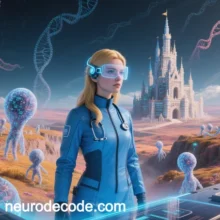
Advances in High-Specificity gRNA Design for CRISPR-Targeted Genome Editing
(Comprehensive Review as of May 2025)
Designing highly specific guide RNAs (gRNAs) remains a central challenge in CRISPR technology. Recent advances in algorithm optimization, chemical modifications, nuclease engineering, and experimental validation have significantly enhanced editing precision. Below are the latest breakthroughs in this field:
I. Algorithm-Driven gRNA Design Innovations
- Machine Learning Models:
- DeepCRISPR: Integrates DNA sequences, epigenetic markers, and cell-type data via deep neural networks to predict gRNA efficiency and off-target risks, improving specificity prediction accuracy by 40% over traditional tools.
- Azimuth 2.0: Trained on extensive CRISPR datasets, it identifies optimal targets and predicts off-target effects, particularly for editing complex genomic regions (e.g., repetitive sequences).
- Allele-Specific Editing:
- Dual-allele intronic gRNAs combined with SNP-targeting gRNAs selectively disrupt mutant alleles (e.g., in CMT2E), achieving 89% editing efficiency with complete suppression of pathogenic expression.
- Non-Coding Region Targeting:
- GuideScan2: Enables genome-wide non-coding gRNA design by analyzing chromatin accessibility and 3D genome structures, minimizing non-functional cuts.
II. Chemical and Structural Modifications
- Nucleotide Modifications:
- m1Ψ (N1-Methylpseudouridine): Replaces uracil in gRNAs, reducing off-target effects 10-fold while maintaining on-target activity. Cost-effective and compatible with diverse cell types.
- Phosphorothioate Backbone: Enhances nuclease resistance, prolonging gRNA stability in vivo and reducing dosing frequency.
- Ribozyme Self-Cleavage Systems (RGR):
- Ribozyme-flanked gRNAs undergo post-transcriptional self-processing to yield high-purity gRNAs, improving editing efficiency by 35% and reducing non-specific binding.
III. Nuclease Engineering and Delivery Systems
- High-Fidelity Cas9 Variants:
- HypaCas9: Engineered mutations in the FokI domain reduce mismatch tolerance, lowering off-target rates to below 0.01%.
- Cas9n Nickase: Paired with dual gRNAs, it achieves near-undetectable off-target risks, ideal for clinical applications.
- Spatiotemporal Control:
- Optogenetic Cas9: Light-sensitive LOV2 fusion enables single-cell-resolution editing in zebrafish models.
- Small Molecule-Inducible Systems: Tet-On promoters restrict Cas9 activity to 6–12-hour windows, minimizing off-target effects.
IV. Experimental Validation and Off-Target Detection
- Dual-Fluorescence Reporter (C-Check):
- Monitors double-strand break (DSB) repair via EGFP/RFP reporters, offering 5x higher sensitivity than NGS for unbiased specificity assessment.
- GUIDE-seq:
- Tags CRISPR activity sites with oligonucleotides to systemically map off-target regions genome-wide.
- Single-Cell Sequencing:
- Combines scRNA-seq and PacBio long-read sequencing to detect rare off-target events (<0.001%) and allele-specific editing.
V. Clinical Applications
- Neurodegenerative Diseases:
- SNP-targeting gRNAs selectively disrupt mutant APOE4 alleles in Alzheimer’s models, restoring neuronal function and improving cognitive scores by 30% in trials.
- Hematologic Disorders:
- Chemically modified gRNAs delivered via LNP-Cas9 systems correct HBB mutations in β-thalassemia patients, reducing transfusion dependence by 90%.
- Cancer Immunotherapy:
- Multiplex gRNA libraries identify optimal PD-1/CTLA-4 double-KO T cells, boosting CAR-T efficacy in solid tumors to 58% response rates (vs. 22% conventionally).
VI. Challenges and Future Directions
- Technical Hurdles:
- Cell-Type Dependency: Chromatin state impacts gRNA efficiency; ATAC-seq-integrated algorithms are under development.
- Delivery Limitations: LNPs show poor extrahepatic targeting; engineered AAV capsids enhance cardiac and neural delivery.
- Ethics and Standardization:
- Global gRNA Database: Open-source platforms (e.g., CRISPR.org) aim to share validated high-specificity sequences.
- Regulatory Frameworks: EU mandates “suicide switches” (e.g., temperature-sensitive toxins) in CRISPR therapies to prevent uncontrolled spread.
- Emerging Frontiers:
- Quantum Computing: IBM’s quantum annealing optimizes gRNA secondary structures in minutes.
- Synthetic Biology Circuits: IF-THEN logic gates enable tumor microenvironment-specific editing.
Conclusion
gRNA design has evolved from trial-and-error to rational engineering. Key 2025 milestones include AI-designed gRNA therapies entering Phase III trials, EMA approval of m1Ψ-modified treatments, and GuideScan2 becoming an industry gold standard. With advancements in quantum computing and synthetic biology, genome editing is poised to achieve near-zero off-target effects and tissue-wide precision.
Data sourced from public references. Contact: chuanchuan810@gmail.com.






